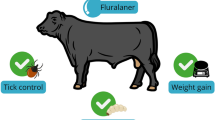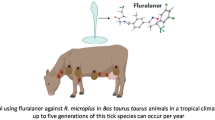Abstract
Purpose
The aim of this study was to evaluate four strategies for application of acaricides to control the tick Rhipicephalus microplus among infested cattle, and to show which of these has the best cost–benefit ratio.
Methods
For this, 72 cattle were selected and divided into four groups: Group 1 (G1): fipronil, pour-on; Group 2 (G2): fluazuron, pour-on; Group 3 (G3): moxidectin, injectable; and Group 4 (G4): chlorpyrifos 30 g, cypermethrin 15 g and fenthion 15 g, spraying (atomizing chamber). Every seven days, the numbers of semi-engorged females were counted and laboratory tests were conducted using different commercial technical-grade products for resistance monitoring.
Results
G4 showed the best percentage reduction, with the highest rate on the seventh day post-treatment (DPT) (83.23%). G3 was the second best strategy, with a percentage of inverse reduction such that the best results were on the 28th DPT (82.85%), while G1 and G2 reached their best results on the 21st DPT (32.63% and 2.79%).
Conclusion
It was noteworthy that the formulation used in G4 was the only one that was efficient for strategic control and that, based on the economic analysis, was shown to be economically viable over the medium term due to the need for investment. The presence of a multidrug-resistant strain in the state of Mato Grosso do Sul in vitro, for the chemical bases amitraz, cypermethrin and cypermethrin + DDVP, is reported here for the first time.
Similar content being viewed by others
References
Grisi L, Leite RC, Martins JRS, Barros ATM, Andreotti R, Cançado PHD, Pérez de León AA, Pereira JB, Villela HS (2014) Reassessment of the potential economic impact of cattle parasites in Brazil. Rev Bras de Parasitol Vet 23:150–156. https://doi.org/10.1590/S1984-29612014042
Narahashi T (1971) Mode of action of pyrethroids. Bull. Org. mond. Sant/ Bull Wld Hlth Org 44:337–345
HayesWayland J Jr (1982) Pesticides studied in man. Willianms and Wilkins, London, p 75
Fukuto TR (1990) Mechanism of action of organophophorus and carbamate insecticides. Environ Health Perspect 87:245–254. https://doi.org/10.1289/ehp.9087245
Bloomquist JR (1993) Toxicology, mode of action and target site-mediated resistance to insecticides acting on choloride channels. Comp Biochem Physiol C Comp Pharmacol Toxicol 106(2):301–314. https://doi.org/10.1016/0742-8413(93)90138-b
Cole LM, Nicholson RA, Casida JE (1993) Action of phenylpyrazole insecticides at the GABA-Gated chloride channel. Pestic Biochem Physiol 46:47–54. https://doi.org/10.1006/pest.1993.1035
Cully DF, Vassilatis DK, Liu KK, Paress PS, Van Der Ploeg LH, Schaeffer JM, Arena JP (1994) Cloning of na avermectin-sensitive glutamate-gated chloride channel from Caenorhabditis elegans. Nature 20(371):707–711. https://doi.org/10.1038/371707a0
Yates DM, Portillo V, Wolstenholm AJ (2003) The avermectin receptors of Haemonchus cotortus and Caenorhabditis elegans. Int J Parasitol 30(33):1183–1193. https://doi.org/10.1016/s0020-7519(03)00172-3
Wolstenholme AJ (2012) Glutamate-gated chloride channels. J Biol Chem 287(48):40232–40238. https://doi.org/10.1074/jbc.R112.406280
Abbas RZ, Zaman MA, Colwell DC, Gilleard J, Iqbal Z (2014) Acaricide resistance in cattle ticks and approaches to its management: the state of play. Vet Par 203:6–20. https://doi.org/10.1016/j.vetpar.2014.03.006
Furlong J, Martins JR, de Prata MC, A, (2007) O carrapato dos bovinos e a resistência: temos o que comemorar? A Hora Vet 27:1–7
Higa LOS, Garcia MV, Barros JC, Koller WW, Andreotti R (2015) Acaricide resistance status of the Rhipicephalus microplus in Brazil: a literature overview. Med Chem 5:326–333. https://doi.org/10.4172/2161-0444.1000281
Prietsch RF, Pereira RA, Brauner CC, Rabassa VR, Corrêa MN, Del Pino FB (2014) Formas farmacêuticas de liberação modificada utilizadas em ruminantes: uma revisão. Sci Anim Heal 2:3–26
De Meneghi D, Stachurski F, Adakal H (2016) Experiences in tick control by acaricide in the traditional cattle sector in Zambia and Burkina Faso: Possible environmental and public health implications. Front Public Health 4:239–249. https://doi.org/10.3389/fpubh.2016.00239
Rodrigues VS, Bonatte Junior P, Garcia MV, Higa LOS, Piña FTB, Zimmermann NP, Duarte PA, Barros JB, Andreotti A (2018) Efficacy profile of Cypermethrin and Chlorpyrifos based acaricides on Rhipicephalus microplus control on cattle in the rearing phase, naturally infested and exposed to tick fever agents in central Brazil. Vet Parasitol Reg Stud Rep 12:43–48. https://doi.org/10.1016/j.vprsr.2018.02.001
Higa LOS, Garcia MV, Rodrigues VS, Bonatte Junior P, Piña FTB, Barros JC, Andreotti R (2019) Effects of cypermethrin, chlorpyrifos and piperonyl butoxide-based pour-on and spray acaricides on controlling the tick Rhipicephalus microplus. Syst Appl Acarol 24(2):278–286
IBGE (2002) Instituto Brasileiro de Geografia e Estatística. In: Mapa de Clima do Brasil, Acesso em 20/03/2018. ftp://geoftp.ibge.gov.br/informacoes_ambientais/ climatologia/mapas/brasil/clima.pdf.
Drummond RO, Ernst SE, Trevino JL, Gladney WJ, Graham OH (1973) Boophilus annulatus and Boophilus microplus: laboratory tests of insecticides. J Econ Entomol 66:130–133. https://doi.org/10.1093/jee/66.1.130
Holdsworth PA, Kemp D, Green P, Peter RJ, De Bruin C, Jonsson N, Letonja T, Rehbein S, Vercruysse J (2006) World Association for the Advancement of Veterinary Parasitology (W.A.A.V.P.) guidelines for evaluating the efficacy of acaricides against ticks (Ixodidae) on ruminants. Vet Parasitol 136:29–43
Sabatini GA, Kemp DH, Hughes H, Nari A, Hansen J (2001) Tests to determine LC50 and discriminating doses for macrocyclic lactones against the cattle tick, Boophilus microplus. Vet Par 95:53–62. https://doi.org/10.1016/s0304-4017(00)00406-4
Reck J, Klafke GM, Webster A, Dall’angol B, Scheffer R, Souza UA, Corassini VB, Vargas R, Santos JS, Martins JRS, (2014) First report of fluazuron resistance in Rhipicephalus microplus: A field tick population resistant to six classes of acaricides. Vet Par 201:128–136. https://doi.org/10.1016/j.vetpar.2014.01.012
Labruna MB, Leite RC, Oliveira PR (1997) Study of the Weight of Eggs from Six Ixodid Species from Brazil. Mem Inst Oswaldo Cruz Rio de Janeiro 92(2):205–207. https://doi.org/10.1590/S0074-02761997000200012
Wharton RH, Utech KBW (1970) The relation between engorgement and dropping of Boophilus microplus (Canestrini) (Ixodidae) to the assessment of the tick numbers on cattle. J Aust Ent Soc 9:171–182. https://doi.org/10.1111/j.1440-6055.1970.tb00788.x
Bovespa, pág. cotações. Índice BOVESPA e cotações grátis de todas as empresas da Bolsa.2018http://app.tororadar.com.br/bovespa/?utm_campaign=286556628&utm_term=10897821828&utm_source=%2Bcota%C3%A7%C3%A3o%20%2Bibovespa&utm_medium=cpc
Higa LOS, Garcia MV, Koller WW, Barros JC, Andreotti R (2016) Evaluation of Rhipicephalus (Boophilus) microplus (Acari: Ixodidae) resistance to different acaricide formulations using samples from Brazilian properties. Rev Bra de Parasitol Vet. https://doi.org/10.1590/S1984-29612016026
Valsoni LM, de Freitas MG, Echeverria JT, Borges DGL, Tutija J, Borges FA (2020) Resistance to all chemical groups of acaricides in a single isolate of Rhipicephalus microplus in Mato Grosso do Sul, Brazil. Inter J Acarol 46:276–280. https://doi.org/10.1080/01647954.2020.1765867
Gupta S, Gupta S (2019) Comparative evaluation of commercial and technical grade deltamethrin and fipronil against Rhipicephalus (Boophilus) microplus. J Vet Parasitol 33(2):30–34. https://doi.org/10.5958/0974-0813.2019.00015.9
Zapa DMB, Couto LFM, Heller LM, Cavalcante ASA, Nicaretta JE, Cruvinel LB, Melo Junior RD, Ferreira LL, Bastos TSA, Soares VE, Mello IAS, Lopes WDZ (2020) Do rainfall and tick burden affect the efficacy of pour-on formulations against Rhipicephalus (Boophilus) microplus? Prev Vet Med 177:104950. https://doi.org/10.1016/j.prevetmed.2020.104950
Cruz BC, Lopes WDZ, Maciel WG, Felipelli G, Fávero FC, Teixeira WFP, Carvalho RS, Ruivo MA, Colli MHA, Sakamoto CAM, Costa AJ, Pereira GO (2015) Susceptibility of Rhipicephalus (Boophilus) microplus to ivermectin (200, 500 and 630 μg/kg) in field studies in Brazil. Vet Par. https://doi.org/10.1016/j.vetpar.2014.12.012
Martins JR, Furlong J (2001) Avermectin resistance of the cattle tick Boophilus microplus in Brazil. Vet Rec 149:64. https://doi.org/10.1023/A:1021656927165
Klafke GM, Sabatini GA, de Albuquerque TA, Martins JR, Kemp DH, Miller RJ, Schumaker TTS (2006) Larval immersion tests with ivermectin in populations of the cattle tick Rhipicephalus (Boophilus) microplus (Acari: Ixodidae) from State of Sao Paulo, Brazil. Vet Parasitol 142:386–390. https://doi.org/10.1016/j.vetpar.2006.07.001
Vilela VLR, Feitosa TF, Bezerra RA, Klafke GM, Riet-Correa F (2020) Multiple acaricide-resistant Rhipicephalus microplus in the semi-arid region of Paraíba State, Brazil. Tick Tick-Borne Dis 11:101–113. https://doi.org/10.1016/j.ttbdis.2020.101413
Camillo G, Vogel FF, Sangioni LA, Cadore GC, Ferrari R (2009) Eficiência in vitro de acaricidas sobre carrapatos de bovinos no estado do rio Grande do sul, Brasil. Cien Rur 39:490–495. https://doi.org/10.1590/S0103-84782008005000082
DA Campos JR, Oliveira RR (2005) Avaliação in vitro da eficácia de acaricidas sobre Boophilus microplus (Canestrini, 1887)(Acari:Ixodidae) de bovinos do município de Ilhéus, Bahia, Brasil. Cien Rur 35:1386–1392. https://doi.org/10.1590/S0103-84782005000600025
Andreotti R, Garcia MV, koller WW, (2019) Carrapatos na cadeia produtiva de bovinos. Embrapa, Brasilia, p 240
Corrêa RR, Lopes WDZ, Teixeira WFP, Cruz BC, Felipelli G, Maciel WG, Fávero FC, Buzzuline C, Bichuette MA, Soares VE, Costa AJ (2015) A comparison of three different methodologies for evaluating Rhipicephalus (Boophilus) microplus susceptibility to topical spray compounds. Vet Par 207:115–124. https://doi.org/10.1016/j.vetpar.2014.11.001
MAPA – Ministério da Agricultura (1987) Normas para registros de parasiticidas de uso pecuário no Brasil. Ministério da Agricultura, Brasília, p 19
Rodrigues DS, Wanderley RPB, Bastianetto E, Cunha AP, Bello ACPP, Barros AB, Leite PVB, Domingues LN, Silva MX, Oliveira PR, Leite RS (2011) Consumo de solução carrapaticida em bovinos, utilizando-se diferentes equipamentos para pulverização. Rev Educ Contin em Med Vet e Zootec do CRMV-SP 9:65–65
Rodrigues DS, Wanderley RPB, Bastianetto E, Cunha AP, Bello ACPP, Barros AB, Leite PVB, Domingues LN, Silva MX, Oliveira PR, Leite RS (2011) Tempo de duração do banho carrapaticida em bovinos, utilizando-se diferentes equipamentos para pulverização. Rev Educ Contin em Med Veterinária e Zootec do CRMV-SP 9:66–66
Bonatte Junior P, Rodrigues VS, Garcia MV, Higa LOS, Zimmermann NP, Barros JC, Andreotti R (2019) Economic performance evaluation of Brangus and Nellore cattle breed naturally infested with Rhipicephalus microplus in an extensive production system in Central- West Brazil. Exp and App Acar 78:567–577. https://doi.org/10.1007/s10493-019-00404-1
Calvano MPCA, Brumatti RC, Barros JC, Garcia MV, Martins KR, Andreotti R (2021) Bioeconomic simulation of Rhipicephalus microplus infestation in different beef cattle production systems in the Brazilian Cerrado. Agricult Syst 15:103247. https://doi.org/10.1016/j.agsy.2021.103247
Pereira MC, Labruna MB, Szabó MPJ, Klafke GM (2008) Rhipicephalus (Boophilus) microplus: biologia, controle e resistência. MedVet, São Paulo. https://doi.org/10.1016/j.agsy.2021.103247
Author information
Authors and Affiliations
Corresponding author
Ethics declarations
Conflict of Interest
There were no conflicts of interest that might have biased the work reported in this paper.
Additional information
Publisher's Note
Springer Nature remains neutral with regard to jurisdictional claims in published maps and institutional affiliations.
Rights and permissions
Springer Nature or its licensor holds exclusive rights to this article under a publishing agreement with the author(s) or other rightsholder(s); author self-archiving of the accepted manuscript version of this article is solely governed by the terms of such publishing agreement and applicable law.
About this article
Cite this article
Junior, P.B., Barros, J.C., Maciel, W.G. et al. Control Strategies for the Tick Rhipicephalus Microplus (Canestrini, 1888) on Cattle: Economic Evaluation and Report of a Multidrug-Resistant Strain. Acta Parasit. 67, 1564–1572 (2022). https://doi.org/10.1007/s11686-022-00611-8
Received:
Accepted:
Published:
Issue Date:
DOI: https://doi.org/10.1007/s11686-022-00611-8




